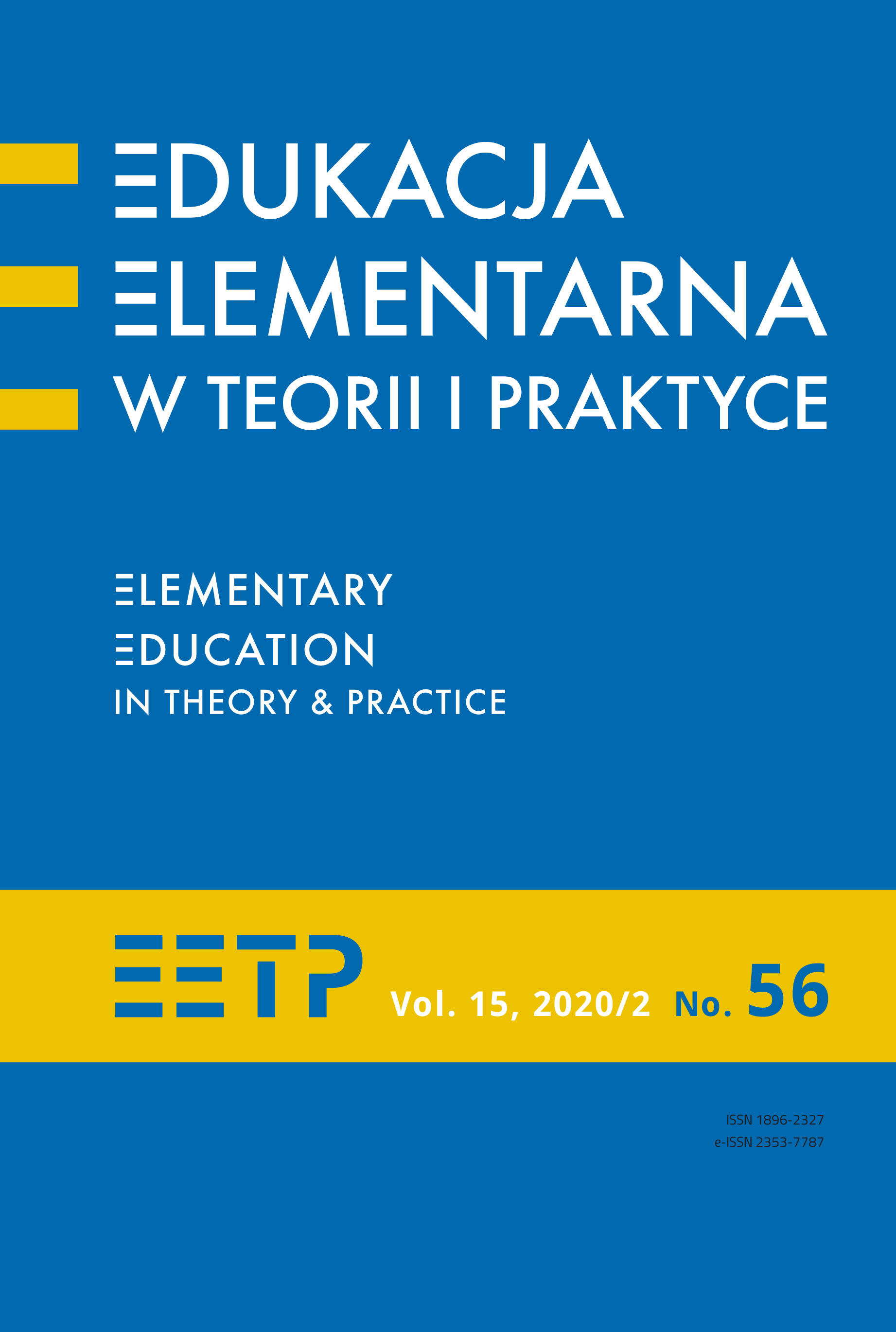The Content of Children’s Stories About the World – an Educational Perspective
Abstract
The author of the article analyses children’s stories about the world. The aim of the research was to answer the question about the content of stories created by six-year-old children. Two groups of research problems were formulated, which took the form of questions. The first group focused on recognizing the subject of children’s stories, their characters and events. The second group was related to answering the question how reality is represented in the situations created by children, taking into account the category of space in terms of near – far. The subject of the research were the texts of 40 stories about the world told by six-year-olds. The descriptive category was made up of the “situation” in which events and characters were placed in the stories created by children. The story of a child included subjectively perceived situations. It was a representation of states of reality, events, and ways of characters’ behaviour. Content analysis was used as a method. The results of the conducted analyses indicate that the stories of girls and boys differ in the way they depict the presented situations, topics, description of events and the background for the ongoing actions. The analysis shows that children focus on positive content related to pleasure and play. The dominant themes are those that capture the characters’ unusual features, their activity and rivalry. Children also take up the subjects related to travelling, adventure, threats, but also to the demonstration of strength or fighting. Recognition in the examined scope will be conducive to the optimisation of activities in the field of designing the educational environment of the youngest.
References
Babbie E. (2009). Podstawy badań społecznych, tłum. W. Bedkiewicz, M. Bucholc, P. Gadomski, J. Haman, A. Jasiewicz-Betkiewicz, A. Kloskowska-Dudzińska, M. Kowalski, M. Mozga-Górecka, Warszawa: Wydawnictwo Naukowe PWN.
Bokus B. (1991). Tworzenie opowiadań przez dzieci. O linii i polu narracji, Kielce: Wydawnictwo Energeia.
Bokus B., Więcko K., Zamęcka J. (1992). Współtworzenie tekstu narracyjnego przez dzieci w wieku przedszkolnym. (O kompetencji komunikacyjnej współnarratora), [w:] B. Bokus, M. Haman (red.), Z badań nad kompetencją komunikacyjną dzieci, Warszawa: Wydaw- nictwo Energeia, s. 125-147.
Dereń E., Polański E. (2008). Wielki Słownik Języka Polskiego, Kraków: Krakowskie Wydawnictwo Naukowe.
Hryniewicka K. (2019). Baśń w życiu dziecka. Cechy, funkcje, rola baśni w życiu dziecka, baśnioterapia, Warszawa: Wydawnictwo Naukowe i Edukacyjne Stowarzyszenia Bibliotekarzy Polskich.
Kosowska E. (2018). Kontekst sytuacyjny a kontekst kulturowy, [w:] B. Bokus, E. Kosowska (red.), Człowiek w sytuacji nie tylko z perspektywy psychologa. Studia inspirowane teorią Tadeusza Tomaszewskiego, Warszawa: Wydawnictwa Uniwersytetu Warszawskiego, s. 42-58.
Markowski A. (red.). (2006). Wielki Słownik Poprawnej Polszczyzny PWN, Warszawa: Wydawnictwo Naukowe PWN.
Shugar G.W., Bokus B. (1988). Twórczość językowa dziecka w sytuacji zabawowo-zadaniowej, Wrocław: Zakład Narodowy im. Ossolińskich Wydawnictwo Polskiej Akademii Nauk.
Silverman D. (2009). Interpretacja danych jakościowych. Metody analizy rozmowy, tekstu i interakcji, tłum. M. Głowacka-Grajper, J. Ostrowska, Warszawa: Wydawnictwo Naukowe PWN.
Uszyńska-Jarmoc J. (2003). Twórcza aktywność dziecka. Teoria – rzeczywistość – perspektywy rozwoju, Białystok: Trans Humana Wydawnictwo Uniwersyteckie.
Wood D. (2006). Jak dzieci uczą się i myślą. Społeczne konteksty rozwoju poznawczego, tłum. R. Pawlik, A. Kowalcze-Pawlik, Kraków: Wydawnictwo Uniwersytetu Jagiellońskiego.
Woynarowska-Sołdan M., Woynarowska B. (2017). Przedszkole Promujące Zdrowie. Po- radnik dla przedszkoli i osób wspierających ich działania w zakresie promocji zdrowia, Warszawa: Ośrodek Rozwoju Edukacji, https://www.ore.edu.pl/2018/02/przedszkole- -promujace-zdrowie/ (dostęp: 14.03.2020).
Copyright (c) 2020 Elementary Education in Theory and Practice

This work is licensed under a Creative Commons Attribution-NoDerivatives 4.0 International License.
- When submitting a text, the author declares that he/she is the Author of the article (hereinafter referred to as the “Work”) and:
- he/she owns the exclusive and unlimited copyright to the Work,
- is entitled to dispose of the copyright to the Work.
Declares that it does not infringe any third party copyrights or legal rights.
Declares that there is no conflict of interest.
2. At the same time, the Author grants the Ignatianum University in Cracowa royalty-free, non-exclusive and territorially unlimited licence to use the Work in the following fields of exploitation:
- recording the Work in a hard copy, as well as on a digital or magnetic medium;
- reproduction of the Work using any technique, without limitation of the number of editions or copies;
- distribution of the Work and its copies on any medium, including marketing, sale, lending, and rental;
- introduction of the Work into a computer memory;
- disseminating the Work in information networks, including in the Internet;
- public performance, exhibition, display, reproduction, broadcasting and re-broadcasting, as well as making the Work available to the public in such a way that everyone can have access to it at a time and place of their own choosing;
- within the scope of dependent rights to the Work, including in particular the right to make necessary changes to the Work resulting from editorial and methodical development, as well as to translate the Work into foreign languages;
The licence is granted from the moment of the transfer of the Work to the Ignatianum University in Cracow. The Ignatianum University in Cracow is entitled to grant further sub-licences to the Work within the scope of the right granted. The licence is time-limited and it is granted for a period of 15 years, starting from the date of its granting.
Authors are permitted and encouraged to publish their text online (e.g. in their institution’s repository or on the institution’s website) before or during the submission process as this may lead to beneficial exchanges, as well as earlier and greater citation of the published text (See The Effect of Open Access). We recommend using any of the following portals of research associations:
- ResearchGate
- SSRN
- Academia.edu
- Selected Works
- Academic Search




